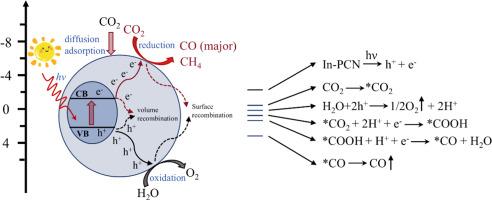含In-N化学键的in改性cn基光催化剂的构建及其光还原CO2的研究
IF 14.3
1区 材料科学
Q1 MATERIALS SCIENCE, MULTIDISCIPLINARY
引用次数: 0
摘要
石墨氮化碳(g-C3N4)作为一种高效的光催化材料,在CO2还原方面受到了广泛的关注。然而,由于光生载流子的复合率高,产物选择性不足,阻碍了其实际应用。本研究通过将MIL-68(In)前驱体与尿素煅烧,成功合成了铟(In)修饰的聚合氮化碳(In- pcn)催化剂,旨在系统研究其光催化CO2还原的调控机制。实验表征表明,微量的In通过In - n键均匀地结合到PCN框架中,保留了其层状多孔结构,同时显著提高了载流子分离效率,降低了界面电荷转移阻力。在可见光照射下,In-PCN的CO产率为19.37 μmol g−1 h−1,选择性为91.5%,比原始PCN提高了2.2倍,循环作用16 h后活性保持稳定。原位傅里叶变换红外光谱(In - ftir)和密度泛函理论(DFT)计算表明,In位点稳定了临界中间体*COOH (ΔG从+2.02 eV降低到+1.03 eV),优化了电子转移途径,从而显著降低了CO2还原的活化能垒。此外,In的加入抑制了H2的生成,通过阻止H2O分子在催化剂表面的解离,提高了CO2的还原效率。带结构分析进一步揭示,In掺杂重构了PCN的电子分布,增强了表面电荷密度,促进了CO2的吸附和选择性还原。本研究为合理设计具有化学配位环境的金属修饰PCN催化剂,推进其在高效、选择性光催化CO2转化中的应用提供了理论见解和实验验证。本文章由计算机程序翻译,如有差异,请以英文原文为准。

Construction of In-modified CN-based photocatalyst with In‒N chemical bond for efficient photoreduction of CO2
Graphitic carbon nitride (g-C3N4), as an efficient photocatalytic material, has garnered significant attention in CO2 reduction. However, its practical application is hindered by the high recombination rate of photogenerated charge carriers and insufficient product selectivity. In this study, an indium (In)-modified polymeric carbon nitride (In-PCN) catalyst was successfully synthesized via calcination of MIL-68(In) precursor with urea, aiming to systematically investigate its regulatory mechanism in photocatalytic CO2 reduction. Experimental characterizations revealed that trace amounts of In were uniformly incorporated into the PCN framework through In‒N bonds, preserving its layered porous structure while significantly enhancing charge carrier separation efficiency and reducing interfacial charge transfer resistance. Under visible-light irradiation, the In-PCN exhibited a CO production rate of 19.37 μmol g−1 h−1 with 91.5% selectivity, representing a 2.2-fold enhancement compared to pristine PCN, and maintained stable activity over 16 h of cyclic operation. In situ Fourier transform infrared (in-FTIR) spectroscopy and density functional theory (DFT) calculations demonstrated that In sites stabilize the critical intermediate *COOH (ΔG decreased from +2.02 eV to +1.03 eV) and optimize electron transfer pathways, thereby significantly lowering the activation energy barrier for CO2 reduction. Furthermore, the incorporation of In suppresses the generation of H2 and increases the reduction efficiency of CO2 by preventing the dissociation of H2O molecules on the catalyst surface. Band structure analysis further revealed that In doping reconstructs the electronic distribution of PCN, enhancing surface charge density to promote CO2 adsorption and selective reduction. This work provides theoretical insights and experimental validation for the rational design of metal-modified PCN catalysts with a chemical coordination environment, advancing their application in efficient and selective photocatalytic CO2 conversion.
求助全文
通过发布文献求助,成功后即可免费获取论文全文。
去求助
来源期刊

Journal of Materials Science & Technology
工程技术-材料科学:综合
CiteScore
20.00
自引率
11.00%
发文量
995
审稿时长
13 days
期刊介绍:
Journal of Materials Science & Technology strives to promote global collaboration in the field of materials science and technology. It primarily publishes original research papers, invited review articles, letters, research notes, and summaries of scientific achievements. The journal covers a wide range of materials science and technology topics, including metallic materials, inorganic nonmetallic materials, and composite materials.
 求助内容:
求助内容: 应助结果提醒方式:
应助结果提醒方式:


